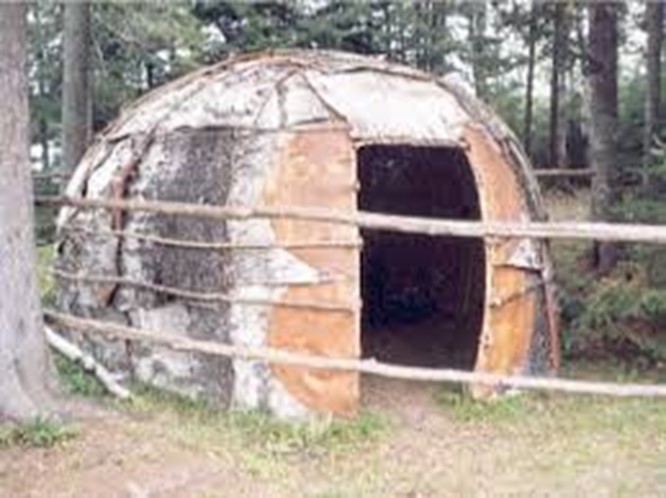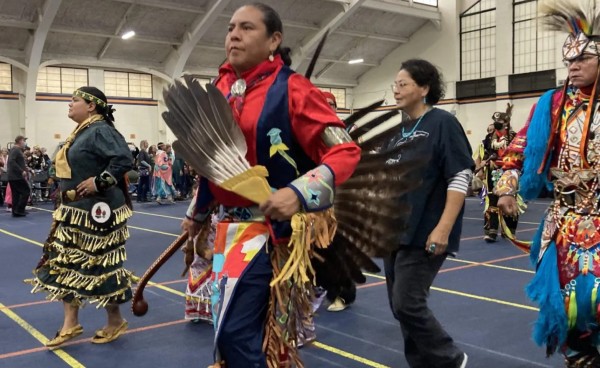By Carol Muskin, Education Guide
When we talk about Chicago’s architecture, we tend to focus on the last 200 years, the period after European-Americans came to dominate the area where the Chicago River flowed into Lake Michigan. We ignore the hundreds of years when the Great Lakes Indigenous people lived in this area; we overlook the contributions they made to the founding and history of Chicago. In this article I will focus on four ideas that illuminate contributions in the areas of architecture, design, foodways, and lifeways.
The first two include the creative use of a plentiful Great Lakes resource—birchbark. Woodland tribes all over the Eastern third of what is now the United States created, and still create, bent sapling housing structures in an oval or domed shape called wigwams. The Council of the Three Fires (Ojibwe, Odawa and Bodéwadmi [Potawatomi]) in the Lake Michigan area harvested birchbark in the spring and early summer to cover their wigwams. It is possible to harvest birchbark (see this video from the Mille Lacs Ojibwe) in a sustainable way so the tree will regrow its bark in about 10 years. Not only are wigwams practical, comfortable, and sustainable, but Mel Rising Dawn Cordiero writes passionately about their symbolism of the “cyclical nature of life and the interconnectedness of all living things.”

Wigwam Building Video Featuring Ojibwe Elder, Nick Hockings, Lac Du Flambeau, Iron River, MI
Perhaps the most meaningful design in North America before the industrial revolution was the birchbark canoe. Anton Treuer, Professor of Ojibwe at Bemidji State University, writes: “The manufacture of the birchbark canoe became a refined and highly specialized art form. It might seem quaint or even cool to some, but few people realize that it was the engine that drove military and financial power for everyone in the region for generations. The fates of tribes and empires were determined by this vessel.” (2) Notably, when the French arrived in the early 1600’s in what is now Northern Michigan, they quickly gave up their clunky wooden watercraft and bought birchbark canoes from the Ojibwe craftsmen. The canoe design developed centuries ago by the Anishinaabe peoples is the same basic design used in modern canoes, albeit with modern materials.
This Indigenous wisdom is carried on today by craftspeople like Wayne Valliere, a teacher with the Lac du Flambeau Band of Lake Superior Chippewa Indians in Wisconsin, who has worked with Native communities and university students at the University of Wisconsin and Northwestern University to make wiigwaasi-jiimaan (birchbark canoes). Interested readers can see the whole process in this 15 minute film, Wiigwaasi-jiimaan, These Canoes Carry Culture.

Launched in October, 2021, this canoe—built by Valliere and team at Northwestern University—is likely the first of its kind to be launched in Lake Michigan since the Ojibwe were forced out of the region by the 1833 Treaty of Chicago. ed into the Great Lakes area for exploration and economic gain. In addition to using Anishinaabe birchbark canoes, these newcomers survived by eating the same natural resources as the locals. With help from the Indigenous people, the settlers learned to gather wild rice, grow the three sisters (corn, beans, and squash), and tap maple trees for sap to boil into maple syrup.
Foodways and lifeways began to be intimately intertwined as non-Natives moved into the Chicago area and French, English, and American men began to take Native wives (1, 2). The non-Native “founding fathers” of Chicago would not have succeeded in their trading and farming enterprises without the skills brought by their wives: Jean Baptiste Point Du Sable and Kitihawa, William Burnett and Kakima, Antoine Ouilmette and Archange, Billy Caldwell and La Nanette, Jean Lalime and Nonkeoqua, etc. The Métis children of these mixed couples became leaders in Chicago. Along with John Kinzie, they sought to continue the friendly relations between Natives and non-Natives in “Indian Country” (1). Ultimately, the leaders/negotiators for the Potawatomie saw the handwriting on the wall and took annuity money in return for giving up their land via the Treaty of 1833 (1), with Caldwell, Shabonna, and the Ouilmettes moving west to Missouri, Iowa, and Kansas.
But that was not the end of the Indigenous peoples’ contributions to Chicago; over 65,000 Indigenous people still live in the Chicago area. Recently Evanston, where I live, celebrated Indigenous People’s Day with a half day of Indigenous educational activities for Evanston Township High School (ETHS) students and a pow wow held in conjunction with The Mitchell Museum of the American Indian. These activities helped us all learn more about the history of Indigenous peoples around the Great Lakes.

Illinois has recently passed three important pieces of legislation that recognize and celebrate the contribution of Indigenous people to our state’s history. HB 1633 requires substantial K-12 education regarding Indigenous history, contributions, current urban Native peoples, and the reality that the U.S. government committed genocide against Indigenous peoples.
Motivated by an incident in which ETHS did not allow an Indigenous student to walk in the graduation procession wearing regalia including a beaded mortarboard and stole made by family members and elders, Indigenous activists worked to pass IL SB 1446 that requires high schools and colleges to allow students to celebrate their graduations by wearing any clothing or accessories that expresses their “cultural, ethnic, or religious identity.” The Indigenous People’s day pow wow at ETHS also celebrated passage of IL HB 4718 to return a small portion of Shabonna’s land, Shab-eh-nay Reservation in DeKalb County, into trust for the Prairie Band of Potawatomie Nation.
Now, for the first time in 175 years, Indigenous people own a small part of Illinois land, land that they made productive via their Indigenous wisdom.
Sources:
- Keating, Ann Durkin (2012) Chicago: The University of Chicago Press. Rising Up from Indian Country: The Battle of Fort Dearborn and the Birth of Chicago.
- Treuer, Anton (2023, Spring Issue) American Craft Magazine. “Inside the Birchbark Canoe.”
 CLICK HERE for more stories on The Bridge.
CLICK HERE for more stories on The Bridge.
Author wearing a vintage native medallion made in Oklahoma and a ribbon skirt of her own design. Carol, who grew up in Muskogee, Oklahoma, is of Cherokee ancestry on her mother’s side and has applied to the Cherokee Nation for her citizenship papers.


Thanks for an interesting and comprehensive article, Carol. We all need to think about the Indigenous peoples’ contributions to Chicago history.
I learned a LOT from your article, Carol. Thanks. I especially appreciated learning about wigwam and canoe architecture, in addition to the indigenous history.